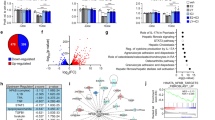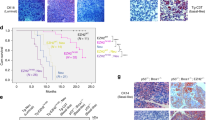Abstract
Increased levels of enhancer of zeste homolog 2 (EZH2), a critical regulator of cellular memory, are associated with negative estrogen receptor (ER) expression and disease progression in breast cancer. High levels of EZH2 signal the presence of metastasis and poor outcome in breast cancer patients. To test the hypothesis that deregulation of EZH2 contributes to ER-negative breast cancer progression, EZH2 expression was inhibited in ER-negative breast cancer cells MDA-MB-231 and CAL51 using a lentivirus system. EZH2 knockdown decreased proliferation and delayed the G2/M cell-cycle transition, although not affecting apoptosis. In vivo, EZH2 downregulation significantly decreased breast xenograft growth and improved survival. EZH2 knockdown upregulated BRCA1 protein. Of note, BRCA1 knockdown was sufficient to rescue the effects of EZH2 downregulation on proliferation, G2/M arrest, and on the levels of hyperphosphorylated mitotic Cdc25C and Cyclin B1 proteins, crucial for entry into mitosis. Invasive ER-negative breast carcinomas show significant overexpression of EZH2 and downregulation of BRCA1 proteins. Taken together, we show that EZH2 is important in ER-negative breast cancer growth in vivo and in vitro, and that BRCA1 is required for the proliferative effects of EZH2. Blockade of EZH2 may provide a prime target to prevent and/or halt ER-negative breast cancer progression.
This is a preview of subscription content, access via your institution
Access options
Subscribe to this journal
Receive 50 print issues and online access
$259.00 per year
only $5.18 per issue
Buy this article
- Purchase on Springer Link
- Instant access to full article PDF
Prices may be subject to local taxes which are calculated during checkout







Similar content being viewed by others
References
American Cancer Society (2008). http://www.cancer.org/docroot/STT/content/STT_1x_Breast_Cancer_Facts__Figures_2007-2008.asp.
Bachmann IM, Halvorsen OJ, Collett K, Stefansson IM, Straume O, Haukaas SA et al. (2006). EZH2 expression is associated with high proliferation rate and aggressive tumor subgroups in cutaneous melanoma and cancers of the endometrium, prostate, and breast. J Clin Oncol 24: 268–273.
Bae I, Rih JK, Kim HJ, Kang HJ, Haddad B, Kirilyuk A et al. (2005). BRCA1 regulates gene expression for orderly mitotic progression. Cell Cycle 4: 1641–1666.
Bonnet J, Mayonove P, Morris MC . (2008). Differential phosphorylation of Cdc25C phosphatase in mitosis. Biochem Biophys Res Commun 370: 483–488.
Bracken AP, Pasini D, Capra M, Prosperini E, Colli E, Helin K . (2003). EZH2 is downstream of the pRB-E2F pathway, essential for proliferation and amplified in cancer. EMBO J 22: 5323–5335.
Bulavin DV, Higashimoto Y, Demidenko ZN, Meek S, Graves P, Phillips C et al. (2003). Dual phosphorylation controls Cdc25 phosphatases and mitotic entry. Nat Cell Biol 5: 545–551.
Cao R, Wang L, Wang H, Xia L, Erdjument-Bromage H, Tempst P et al. (2002). Role of histone H3 lysine 27 methylation in Polycomb-group silencing. Science 298: 1039–1043.
Collett K, Eide GE, Arnes J, Stefansson IM, Eide J, Braaten A et al. (2006). Expression of enhancer of zeste homologue 2 is significantly associated with increased tumor cell proliferation and is a marker of aggressive breast cancer. Clin Cancer Res 12: 1168–1174.
Cortez D, Wang Y, Qin J, Elledge SJ . (1999). Requirement of ATM-dependent phosphorylation of brca1 in the DNA damage response to double-strand breaks. Science 286: 1162–1166.
Ding L, Erdmann C, Chinnaiyan AM, Merajver SD, Kleer CG . (2006). Identification of EZH2 as a molecular marker for a precancerous state in morphologically normal breast tissues. Cancer Res 66: 4095–4099.
Dunphy WG . (1994). The decision to enter mitosis. Trends Cell Biol 4: 202–207.
Ellis M, Hayes D, Lippman M . (2000). Treatment of metastatic disease. In: Harris J, Lippman ME, Morrow M (eds). Diseases of the Breast. Lippincott-Raven: Philadelpha, pp 749–798.
Elstrodt F, Hollestelle A, Nagel JH, Gorin M, Wasielewski M, van den Ouweland A et al. (2006). BRCA1 mutation analysis of 41 human breast cancer cell lines reveals three new deleterious mutants. Cancer Res 66: 41–45.
Fan M, Du L, Stone AA, Gilbert KM, Chambers TC . (2000). Modulation of mitogen-activated protein kinases and phosphorylation of Bcl-2 by vinblastine represent persistent forms of normal fluctuations at G2–M1. Cancer Res 60: 6403–6407.
Foulkes WD, Stefansson IM, Chappuis PO, Begin LR, Goffin JR, Wong N et al. (2003). Germline BRCA1 mutations and a basal epithelial phenotype in breast cancer. J Natl Cancer Inst 95: 1482–1485.
Hayes DF, Isaacs C, Stearns V . (2001). Prognostic factors in breast cancer: current and new predictors of metastasis. J Mammary Gland Biol Neoplasia 6: 375–392.
Hoffmann I, Clarke PR, Marcote MJ, Karsenti E, Draetta G . (1993). Phosphorylation and activation of human cdc25-C by cdc2–cyclin B and its involvement in the self-amplification of MPF at mitosis. EMBO J 12: 53–63.
Jacobs JJ, Kieboom K, Marino S, DePinho RA, van Lohuizen M . (1999a). The oncogene and Polycomb-group gene bmi-1 regulates cell proliferation and senescence through the ink4a locus. Nature 397: 164–168.
Jacobs JJ, Scheijen B, Voncken JW, Kieboom K, Berns A, van Lohuizen M . (1999b). Bmi-1 collaborates with c-Myc in tumorigenesis by inhibiting c-Myc-induced apoptosis via INK4a/ARF. Genes Dev 13: 2678–2690.
Kirmizis A, Bartley SM, Kuzmichev A, Margueron R, Reinberg D, Green R et al. (2004). Silencing of human polycomb target genes is associated with methylation of histone H3 Lys 27. Genes Dev 18: 1592–1605.
Kleer CG, Cao Q, Varambally S, Shen R, Ota I, Tomlins SA et al. (2003). EZH2 is a marker of aggressive breast cancer and promotes neoplastic transformation of breast epithelial cells. Proc Natl Acad Sci USA 100: 11606–11611.
Kuzmichev A, Nishioka K, Erdjument-Bromage H, Tempst P, Reinberg D . (2002). Histone methyltransferase activity associated with a human multiprotein complex containing the Enhancer of Zeste protein. Genes Dev 16: 2893–2905.
Laible G, Wolf A, Dorn R, Reuter G, Nislow C, Lebersorger A et al. (1997). Mammalian homologues of the Polycomb-group gene Enhancer of zeste mediate gene silencing in Drosophila heterochromatin and at S. cerevisiae telomeres. EMBO J 16: 3219–3232.
Lakhani SR, Reis-Filho JS, Fulford L, Penault-Llorca F, van der Vijver M, Parry S et al. (2005). Prediction of BRCA1 status in patients with breast cancer using estrogen receptor and basal phenotype. Clin Cancer Res 11: 5175–5180.
MacLachlan TK, Somasundaram K, Sgagias M, Shifman Y, Muschel RJ, Cowan KH et al. (2000). BRCA1 effects on the cell cycle and the DNA damage response are linked to altered gene expression. J Biol Chem 275: 2777–2785.
Mullan PB, Quinn JE, Harkin DP . (2006). The role of BRCA1 in transcriptional regulation and cell cycle control. Oncogene 25: 5854–5863.
Narod SA, Foulkes WD . (2004). BRCA1 and BRCA2: 1994 and beyond. Nat Rev Cancer 4: 665–676.
Peng CY, Graves PR, Thoma RS, Wu Z, Shaw AS, Piwnica-Worms H . (1997). Mitotic and G2 checkpoint control: regulation of 14-3-3 protein binding by phosphorylation of Cdc25C on serine-216. Science 277: 1501–1505.
Ringrose L, Paro R . (2004). Epigenetic regulation of cellular memory by the Polycomb and Trithorax group proteins. Annu Rev Genet 38: 413–443.
Roshak AK, Capper EA, Imburgia C, Fornwald J, Scott G, Marshall LA . (2000). The human polo-like kinase, PLK, regulates cdc2/cyclin B through phosphorylation and activation of the cdc25C phosphatase. Cell Signal 12: 405–411.
Satijn DP, Otte AP . (1999). Polycomb group protein complexes: do different complexes regulate distinct target genes? Biochim Biophys Acta 1447: 1–16.
Shi B, Liang J, Yang X, Wang Y, Zhao Y, Wu H et al. (2007). Integration of estrogen and Wnt signaling circuits by the polycomb group protein EZH2 in breast cancer cells. Mol Cell Biol 27: 5105–5119.
Smits VA, Medema RH . (2001). Checking out the G(2)/M transition. Biochim Biophys Acta 1519: 1–12.
Strausfeld U, Fernandez A, Capony JP, Girard F, Lautredou N, Derancourt J et al. (1994). Activation of p34cdc2 protein kinase by microinjection of human cdc25C into mammalian cells. Requirement for prior phosphorylation of cdc25C by p34cdc2 on sites phosphorylated at mitosis. J Biol Chem 269: 5989–6000.
Su IH, Dobenecker MW, Dickinson E, Oser M, Basavaraj A, Marqueron R et al. (2005). Polycomb group protein ezh2 controls actin polymerization and cell signaling. Cell 121: 425–436.
Tonini T, Bagella L, D'Andrilli G, Claudio PP, Giordano A . (2004). Ezh2 reduces the ability of HDAC1-dependent pRb2/p130 transcriptional repression of cyclin A. Oncogene 23: 4930–4937.
Turner N, Tutt A, Ashworth A . (2004). Hallmarks of ‘BRCAness’ in sporadic cancers. Nat Rev Cancer 4: 814–819.
Turner NC, Reis-Filho JS, Russell AM, Springall RJ, Ryder K, Steele D et al. (2007). BRCA1 dysfunction in sporadic basal-like breast cancer. Oncogene 26: 2126–2132.
Varambally S, Dhanasekaran SM, Zhou M, Barrette TR, Kumar-Sinha C, Sanda MG et al. (2002). The polycomb group protein EZH2 is involved in progression of prostate cancer. Nature 419: 624–629.
Venkitaraman AR . (2002). Cancer susceptibility and the functions of BRCA1 and BRCA2. Cell 108: 171–182.
Wilson CA, Ramos L, Villasenor MR, Anders KH, Press MF, Clarke K et al. (1999). Localization of human BRCA1 and its loss in high-grade, non-inherited breast carcinomas. Nat Genet 21: 236–240.
Xu B, Kim S, Kastan MB . (2001). Involvement of Brca1 in S-phase and G(2)-phase checkpoints after ionizing irradiation. Mol Cell Biol 21: 3445–3450.
Yan Y, Spieker RS, Kim M, Stoeger SM, Cowan KH . (2005). BRCA1-mediated G2/M cell cycle arrest requires ERK1/2 kinase activation. Oncogene 24: 3285–3296.
Yoshikawa K, Ogawa T, Baer R, Hemmi H, Honda K, Yamauchi A et al. (2000). Abnormal expression of BRCA1 and BRCA1-interactive DNA-repair proteins in breast carcinomas. Int J Cancer 88: 28–36.
Yuli C, Shao N, Rao R, Aysola P, Reddy V, Oprea-llies G et al. (2007). BRCA1a has antitumor activity in TN breast, ovarian and prostate cancers. Oncogene 26: 6031–6037.
Acknowledgements
We thank Dr Arul Chinnaiyan for the EZH2 plasmid, and Tracey Filzen for technical support. We thank Robin Kunkel for assistance with artwork. We thank the University of Michigan Vector Core for virus generation. This work was supported by NIH grants CA090876 (CGK), CA107469 (CGK), CA77612 (SDM), a grant from the Avon Foundation (CGK), a grant from the Burroughs Wellcome Fund (SDM) and a grant from the Department of Defense Breast Cancer Research Program (ACV).
Author information
Authors and Affiliations
Corresponding author
Additional information
Supplementary Information accompanies the paper on the Oncogene website (http://www.nature.com/onc)
Rights and permissions
About this article
Cite this article
Gonzalez, M., Li, X., Toy, K. et al. Downregulation of EZH2 decreases growth of estrogen receptor-negative invasive breast carcinoma and requires BRCA1. Oncogene 28, 843–853 (2009). https://doi.org/10.1038/onc.2008.433
Received:
Revised:
Accepted:
Published:
Issue Date:
DOI: https://doi.org/10.1038/onc.2008.433
Keywords
This article is cited by
-
EZH2 Contributes to Anoikis Resistance and Promotes Epithelial Ovarian Cancer Peritoneal Metastasis by Regulating m6A
Current Medical Science (2023)
-
Methylation-dependent and -independent roles of EZH2 synergize in CDCA8 activation in prostate cancer
Oncogene (2022)
-
Regulation of CCL2 by EZH2 affects tumor-associated macrophages polarization and infiltration in breast cancer
Cell Death & Disease (2022)
-
Decreased PRC2 activity supports the survival of basal-like breast cancer cells to cytotoxic treatments
Cell Death & Disease (2021)
-
MiR-33a functions as a tumor suppressor in triple-negative breast cancer by targeting EZH2
Cancer Cell International (2020)



